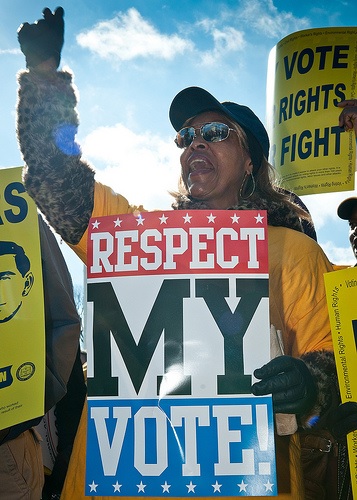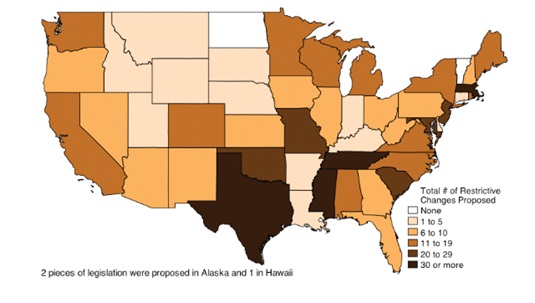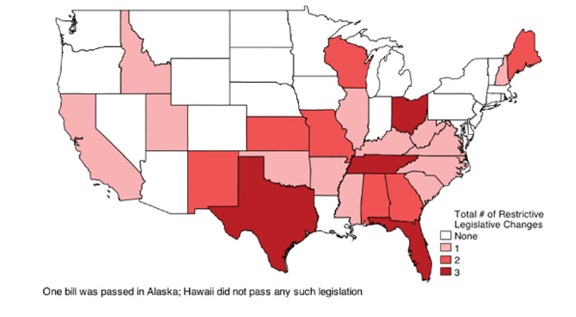
 In the past two elections there has been a dramatic increase in the number of restrictive voting laws passed at the state level. Support for these laws tends to break along party lines, with Republicans claiming these laws are needed to defend against voter fraud, and Democrats arguing that it is actually a form of voter suppression. In their recent research, Keith Gunnar Bentele and Erin O’Brien show that these proposals tend to be introduced in battleground states after periods of increased voter turnout among minority and low-income groups and are passed more frequently under Republican-controlled state legislatures.
In the past two elections there has been a dramatic increase in the number of restrictive voting laws passed at the state level. Support for these laws tends to break along party lines, with Republicans claiming these laws are needed to defend against voter fraud, and Democrats arguing that it is actually a form of voter suppression. In their recent research, Keith Gunnar Bentele and Erin O’Brien show that these proposals tend to be introduced in battleground states after periods of increased voter turnout among minority and low-income groups and are passed more frequently under Republican-controlled state legislatures.
Last week Ohio’s Republican Secretary of State announced the state would no longer offer early voting on Sundays or weekday evenings. This comes on the heels of recent bills passed by the Ohio legislature which reduced early voting, eliminated a week during which Ohioans could both register and vote, and made it more difficult to vote by absentee ballot. All of these bills passed along party lines, with Republicans voting in favour and Democrats against. These developments are just the most recent in a veritable flood of new laws passed in the last couple of years that limit access to the polls in various ways. Most common are laws which require would-be voters to show specific kinds of photo identification before they can vote, reduce early voting, repeal same-day voter registration, increase regulation of organizations and individuals who aim to register new voters, and make absentee voting less accessible. Studies show that such measures have the potential to dissuade or disenfranchise significant numbers of voters. Further, minorities, young people, and the very old are especially likely to be hampered. Since these groups disproportionately vote for Democrats, the new restrictions have the potential to impact election outcomes.

Between 2006 and 2010, states passed a total of 18 restrictive changes to state voting laws. Within the years of 2011-2013 alone, various states have passed roughly 70 restrictive changes while over 300 restrictions were proposed. What explains this dramatic shift toward restriction of voter access? On the left, voter identification laws are viewed as thinly veiled attempts by Republicans to depress turnout among Democratic-leaning constituencies, such as minorities, new immigrants, the elderly, disabled, and young. On the right, these laws are viewed as a bulwark against electoral fraud and a means of preserving electoral legitimacy. In our recent research, we examined the dominant explanations (and accusations) advanced by both the right and left, as well as the factors political scientists know are important for understanding state legislative activity.
In practice, it is not possible to study the personal motives of state legislators who propose or vote for hundreds of pieces of legislation across many states. But we can systematically explore the patterns and timing of legislative activity in states with different social characteristics and political histories. In other words, we can assess what types of states have been more or less active in proposing and passing voter restrictions. We did precisely this type of analysis for state-level voting laws proposed and legislation actually passed from 2006 to 2011 (the proposed and passed restrictions are shown in Figures 1 and 2).
Figure 1: Proposed Restrictive Voter Provisions: 2006-2011
 Figure 2: Passed Restrictive Voter Provisions: 2006-2011
Figure 2: Passed Restrictive Voter Provisions: 2006-2011

Our results are striking, we found that restrictive proposals were introduced more often in states with larger African-American and non-citizen populations, higher minority turnout, as well as in states where both minority and low-income turnout recently increased (in this case, during the 2008 election). Such laws passed more frequently in states where the proportion of Republicans in the legislature went up or a Republican governor was elected. In fact, of the 41 adopted voter restrictions passed from 2006 to 2011, 34 (or 83%) were passed by Republican-controlled state legislatures. Furthermore, all bills requiring either photo ID or proof of citizenship passed in legislatures under Republican control. Additionally, increased competitiveness in the state’s previous presidential election contest was associated with more restrictive policy changes in states with larger Republican majorities (but led to fewer restrictive laws in states with larger Democratic majorities). Finally, our results showed that states where minority turnout has increased since the previous presidential election were more likely to pass restrictive legislation.
Taken together, these findings are consistent with the narrative that recent restrictions on voter access are intended to suppress minority votes. Our results strongly suggest that opponents of these new constraints are justified in their concern that these laws have partisan goals and take aim along racial lines.
These findings are especially relevant in the wake of the June 2013 Supreme Court ruling in Shelby County v. Holder, which greatly reduces federal supervision of voting rules in states and counties previously covered by Section 5 of the Voting Rights Act of 1965. Under that provision, jurisdictions with a demonstrated history of discrimination against minority voters had to clear any new voting rules the Justice Department before the changes could be implemented. Now, all states are free to proceed without this federal check prior to implementation. A key argument made against the constitutionality of the Section 5 was that the “pre-clearance” rules are no longer necessary because states today have no intention to discriminate. Our findings call such assertions into question and, more broadly, suggest that challenges to the implementation and passage of voter access legislation are indeed merited on the grounds of racial bias.
Furthermore, expectations based on these findings have been born out in the pattern of states that have continued to pass restrictions since 2011. In 2013 North Carolina infamously passed “the country’s worst voter suppression law”. And recent developments in Ohio are especially troubling given that in the 2004 Ohio voters experienced numerous difficulties including incredibly long lines in some precincts (while President Bush’s two percentage point margin of victory in Ohio secured his reelection). However, it should also be mentioned that Democrats have not taken these developments lying down. The Democratic National Committee recently announced a plan to fund and staff a permanent effort to combat voter suppression in battleground states. And in the last couple of years states under Democratic control have worked to significantly expand the accessibility of state election systems by introducing online voter registration, expanding early voting, and implementing Election Day registration. In fact, the pushback has been so strenuous that a new report from the Brennan Center indicates that the rate of introduction of state level proposals that expand voter access have significantly outstripped the number of proposed restrictions. Consequently, the accessibility of elections across states is currently in a remarkable state of flux, with elections becoming more and less accessible depending on which party is in charge. Moving forward the future of voting rights in the U.S. will be shaped by the ongoing political contest between the Republican and Democratic parties. At the same time, this contest itself will be influenced by the continuing political and legal struggles over access to the ballot.
This article is based on the paper “Jim Crow 2.0? Why States Consider and Adopt Restrictive Voter Access Policies,” which appeared in Perspectives on Politics.
Featured image credit: SEIU International (Creative Commons BY NC SA)
Please read our comments policy before commenting.
Note: This article gives the views of the authors, and not the position of USApp– American Politics and Policy, nor of the London School of Economics.
Shortened URL for this post: http://bit.ly/1eR1s0r
_________________________________
 Keith G. Bentele- University of Massachusetts, Boston
Keith G. Bentele- University of Massachusetts, Boston
Keith G. Bentele is an Assistant Professor of Sociology at the University of Massachusetts, Boston. His research has examined the consequences of welfare reform, rising earnings inequality in the U.S., and the passage of multiple types of state legislation sought by the conservative Evangelical movement. His current research includes continuing research on the passage of restrictions on voter access.
 Erin E. O’Brien- University of Massachusetts, Boston
Erin E. O’Brien- University of Massachusetts, Boston
Erin E. O’Brien is an Associate Professor of Political Science at the University of Massachusetts, Boston and faculty affiliate in the McCormack Graduate School of Policy Studies and Women Studies. She has published extensively on politics, policy, and inequality in the American case. Her work appears in venues including The American Journal of Political Science, Political Research Quarterly, Women & Politics as well as books with The State University of New York Press and Longman Press respectively.




1 Comments